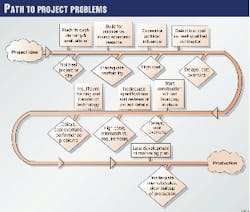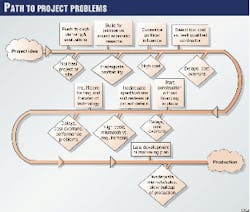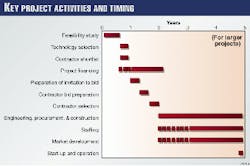Industry can learn from past project failures
The surge of new plant projects built in developing economies during the past 15 years includes both successes and failures.
Companies can learn from these experiences by identifying key factors that resulted in major project problems or project successes.
This article reviews projects that had noteworthy (and sometimes disastrous) developments. Analyzing past projects sheds light on what should or should not be done on future ones.
Approaching this subject through cases in which major problems developed, rather than presenting a sterile list of problems, makes the problems more memorable. The specific projects involved have not been identified for obvious reasons. Since the key elements are not unique to any one project, readers will be able to match them to projects of their own experience.
The focus is on plants that moved beyond planning to construction, although there are certainly many lessons to be learned from problems in project planning. The discussion is also limited to projects in developing economies. Problems in developed economies generally result from different factors than those examined here.
The projects described were built in the developing economies of Asia, Latin America, and Africa; but, as stated, similar problems have occurred virtually everywhere. Fig. 1 illustrates mistakes made at key project steps and the resulting problems caused by these mistakes.
The case descriptions are organized and presented according to the key issue or problem involved, which provides a checklist of mistakes to be avoided.
Note that it is only too easy to think that the problems and situations described are obvious and should clearly have been avoided. This perspective ignores the circumstances and environments surrounding projects and their timing. Hindsight is always accurate; however, the author admits to frustrated attempts to convince companies to take steps that would have avoided some of these described problems.
The following case studies should be instructive:
- Starting construction without finalizing arrangements for project financing.
- Building a project without a marketing plan.
- Delegation of project details and specifications to the licensor or contractor.
- Insufficient training and transfer of technology.
- Excessive political influence.
- Rush to construction without adequate evaluation and planning.
- Building a project for "political" rather than for good business or economic reasons.
- Selecting a low-cost engineering, procurement, and construction (EPC) contractor without adequate consideration of the contractor's experience in the country or region and with the technology involved.
Lack of finalized financing
In the enthusiasm of implementing a "wonderful" project, several ventures proceeded to construction using equity funds. These confident managers assumed that finalizing the arrangements for project financing would be "no problem."
Unfortunately, arranging or finalizing financing does not always go smoothly. Some projects halted construction after equity funds were exhausted and the loans were not yet in place. The consequences included delays, cost overruns, loss of negotiating position for the loans, and the need to seek new partners under difficult circumstances.
These ventures learned important lessons: Incorporate project financing as an integral part of the planning and implementation process, bring a financial advisor into the feasibility-study work, and finalize loan arrangements before construction begins.
Lack of a marketing plan
With the confidence in a "terrific" project, several ventures proceeded to build plants without carefully developed marketing plans.
In one case, with a project producing a commodity product, the realization that one could not just put the product onto ships sent into the international market without customer arrangements did not surface until the plant was almost completed.
Hasty arrangements were made at the last moment. These arrangements were not done in an optimal manner and were made with a great deal of anxiety.
In other cases, plants were built in the expectation that a significant amount of uncommitted production would be sold to China. Unfortunately, the Chinese did not recognize any obligation to consume this material. The consequence was surplus product pushed into the marketplace.
The lesson learned here is that proper market analysis should be done as part of project planning, and detailed market plans and contracts should be developed well in advance of start-up.
Delegation of authority
Without detailed knowledge of the process technology or without the staff capable of monitoring the work of a licensor or contractor, several companies left decisions concerning process equipment, instrumentation, and process control specifications to the licensor and contractor.
In one case, the result was the most sophisticated and over-instrumented and controlled plant of its kind ever built, using all of the sophisticated systems that the licensor and contractor thought would benefit the owner. The plant was not only extremely costly, but the plant-control systems were not suitable for the level of sophistication of the company's operators and maintenance personnel.
In another case, the contractor included work on some facilities for a second stage of the project that the owner had been planning but had not made the decision to implement. The result was costs incurred for facilities never used and that the owner had not yet formally approved.
The lesson to be learned from these examples is that the owner must be involved in key technology and operations decisions, retaining independent advisors on his behalf, if necessary, to serve this function.
Insufficient training
Plant operating and local construction personnel must be experienced or receive adequate training.
In one case, training was inadequate through the entire project, from local engineering work through plant operating and maintenance personnel. The international contractor did not recognize the need for additional training and supervision of the local subcontractors, and the owner did not accept the need for thorough training of operating and maintenance staff.
The result was a wide range of problems: long delays in mechanical completion, start-up, and production; substantial cost overruns; difficulties in producing on-specification products and in maintaining plant operations; high costs caused by considerable off-specification product; and problems in establishing markets with satisfied customers.
There was an important lesson to be learned: The owner must ensure that both the owner and the licensor or contractor are aware of the capabilities of and training necessary for local staff.
The international contractor must provide adequate training and supervision for work performed by local subcontractors; qualified operating personnel need to be hired, adequately trained by the technology licensor, and backed up for as long as necessary.
Political influence
Excessive political influence has significant negative effects on many projects. A typical result is higher capital costs, the consequence of costs imposed by influential parties along the project development and implementation ladder.
It is not unusual for political influences to add 15 to 25% to total installed costs. Legendary tales claim much higher costs.
An interesting story involved a project for which the final capital cost was reported to have been established by what project economics were capable of supporting.
There are other equally important political effects on projects, which should be noted: delays in project planning and awards (as parties maneuver to get aligned or capture a favored position) and award of contracts to favored parties rather than the most qualified or lowest-cost bidders.
Partisan awards cause not only higher costs, but also uncertainties of competency.
Many projects have suffered from the effects of both delays in implementation and high cost contracts as the consequence of political contacts.
In one project that awarded the contract to unqualified companies, there was concern that the selected (politically favored) site contractor might do such a poor job of site preparation that the towers might tilt or fall over. In this case, it was fortunate that the project was stopped at this point, for other political reasons, to proceed later under a different political environment.
Government authorities need to control the level of political effects on projects and keep them to a reasonable level.
Inadequate planning
Sometimes enthusiasm for a project bypasses reasonable planning and evaluation steps. A couple of examples of negative effects illustrate problems that can result.
One project was developed with the initial feedstock selected for the design basis, without thorough consideration of the long-term availability of this feedstock and the effect of using alternative feedstocks.
The result was a design basis that lacked the flexibility to properly handle economically available alternative feedstocks.
In another case, the project proceeded to construction without careful analysis of logistical considerations at the site and alternative locations. As the project was under construction, panic developed as it became clear that there were significant logistical disadvantages to this site. The owner considered abandoning the original site and shifting the project to another location.
In both of these cases, the result was projects with less than optimal profitability. The lesson is enthusiasm must not be allowed to overrun reasonable planning and evaluation procedures.
Unsound economic basis
There have been many cases in which the motivating force behind a project has been primarily political rather than economic and strategic.
In the worst example with which the author is familiar, an international lending agency prepared a review of an unsuccessful project. This analysis pointed out the following problems experienced on this project, which was built in a very poor country:
- The project was poorly planned. The country could not consume the production from the project, nor could nearby markets consume the exports.
- The project was poorly executed at very high costs.
- The facilities were poorly maintained by staff who were not provided with the necessary training or materials.
The project eventually shut down, becoming a rusting heap of materials and equipment. The country remained saddled with the debt payments.
A more common problem is projects proposed by government agencies to gain social and economic benefits. These projects are initiated on the understanding that the project will have a lower than "normal" return on investment.
What is not always clear to the parties involved, however, is the implication of "low" return, although the projects are generally expected to be economically self-sustaining.
The economics of project financing, however, demonstrate that a project with a rate of return lower than the cost of its loans will never be able to pay off the loans. By presenting the economics of a project on this basis, projects planned without sound fundamental economics can be terminated before too much effort has been expended.
If a government really wants the project to proceed, it must provide the means for the project to achieve sustainable economics. The lesson to be learned from these experiences: Projects need conventional business economics and proper implementation to ensure their viability.
Wrong EPC contractor
Besides cost, selection of an EPC contractor must consider the contractor's experience in the country and with the technology involved.
In one case, a fully qualified contractor's price was considered too high, and a lower-cost contractor was selected. The selected contractor did not have much experience in either building plants in the country in question nor with similar technologies.
The result was a project that was delayed and at a higher cost than expected. The owner paid for overruns, and the final cost was about the same as that quoted by the better-qualified contractor.
The lesson here is that the low bid price can be the best price only if the contractor is as qualified as a competent higher bidder.
Steps for success
What perspectives can be gained through a review of these project profiles?
First, most of the problems described could have been avoided with good planning and management. For some problems, however, such as those associated with political influence, one must recognize that the problem will exist and deal directly with it.
This would include assessing the alternatives of dealing with influence and the extent and effect on the project, as well as deciding if this might preclude participation in the project.
Having reviewed mistakes on projects, this article now focuses on the steps for successfully implementing a new project. Fig. 2 shows the broad steps and associated timeline in developing and implementing a project.
The timeline indicates about 2 years for all of the planning, study work, selection, and award of contracts for technology and EPC, and project financing. The pre-EPC work could range from 11/2 years to 3+ years. Fig. 2 allots 2-3 years for EPC, which covers the time required for most projects.
Feasibility studies typically proceed through various levels of detail: opportunity screening, prefeasibility studies of short-listed projects, and detailed feasibility study of the selected project. Work stops if negative conclusions are reached at any level of detail.
The time required for feasibility studies could expand to more than a year if the project is complex and involves reviews and decisions by multiple partners. The scope and contents of a typical detailed feasibility study is indicated in Table 1.
It is essential to have a professionally prepared, independent feasibility study by a respected company to ensure its acceptance by potential partners and lenders.
After the detailed feasibility study is completed and the decision has been made to proceed with project implementation, the owner must select the technology and EPC contractor, usually through the means of evaluations of bids.
For some technologies, typically those which produce commodity products sold on a specification or purity basis (ethylene, for example), the selection process is typically combined for technology and the lump-sum turnkey EPC price for the plant.
This ensures that the consideration of the effect of variations in technology on the cost of the plant is included in the overall evaluation and selection process. The one-step process also reduces the time required for evaluation and selection of technology and contractors.
For technologies for which product-performance characteristics and differences are important (polyethylene, for example), technology is selected first. The EPC bids are then based on a basic engineering package prepared by the selected licensor.
This selection process is critical, since, as noted previously, faults in this step can result in major problems later. The short-listing of bidders (licensors or contractors) must result in a bidders list that contains only fully qualified parties.
The invitation to bid (ITB) documents should also be sufficiently complete and well thought out so that bidders submit comparable bids. Good ITB documents enable the owner to assess bids without major uncertainties concerning differences in scope.
In preparing the ITB, the owner's team should be considering its evaluation criteria and ranking process to ensure that the necessary details will be provided and that the bidders understand what the owner considers to be particularly important.
The selection of licensors and contractors should be based not only on cost, but also on such less-tangible factors as experience or reputation with the technology and in the country, training and transfer of technology to be provided, and guarantees.
The owner must review and approve the design and EPC for the project. If the owner has no experienced staff to perform these functions, an outside staff should be retained for this work.
If the project is to proceed with project financing (as opposed to corporate funding), this should be incorporated into the development of the feasibility study. While the lenders (mainly international banks) will have similar concerns and interests to an owner's management, they require more documentation and contracts than an operating company's management might insist on before signing off on a project.
For example, company management might be comfortable that raw material supply and product sales contracts will be executed when needed, but lenders will insist that these contracts formally be in place before the loans are approved. Thus, many key issues must be addressed as the project is developed to ensure that the funds can be available when needed.
Staffing and training for a new project should take place over the entire EPC period. The licensor or contractor should provide a substantive training program. An extensive and comprehensive training program is an excellent investment for the owner. One of the best project implementations was done by a company that invested in a very intensive training program for staff members hired on the basis of good talent.
Finally, the market development activities for new projects should take place over the extended period of project implementation-not in a fever pitch as start-up approaches. This manner allows time for seeding and developing markets for new products and for building relationships with important customers. Once again, early and careful work pays dividends.
Table 2 shows the key issues and approaches that need to be carefully addressed by an owner to avoid the problems identified on the projects previously described.
The Author
Stephen N. Rothman recently retired as a vice-president of Chem Systems Inc., Tarrytown, NY, and director of Chem Systems East Asia, Bangkok.
Rothman has more than 30 years' experience in the petrochemical and energy industries. He has served as commercial or technical advisor on negotiations for joint ventures, raw material and product contracts, project financing, and mergers and acquisitions for governments and private companies. He holds a BChE from Rensselaer Polytechnic Institute, Troy, NY.



